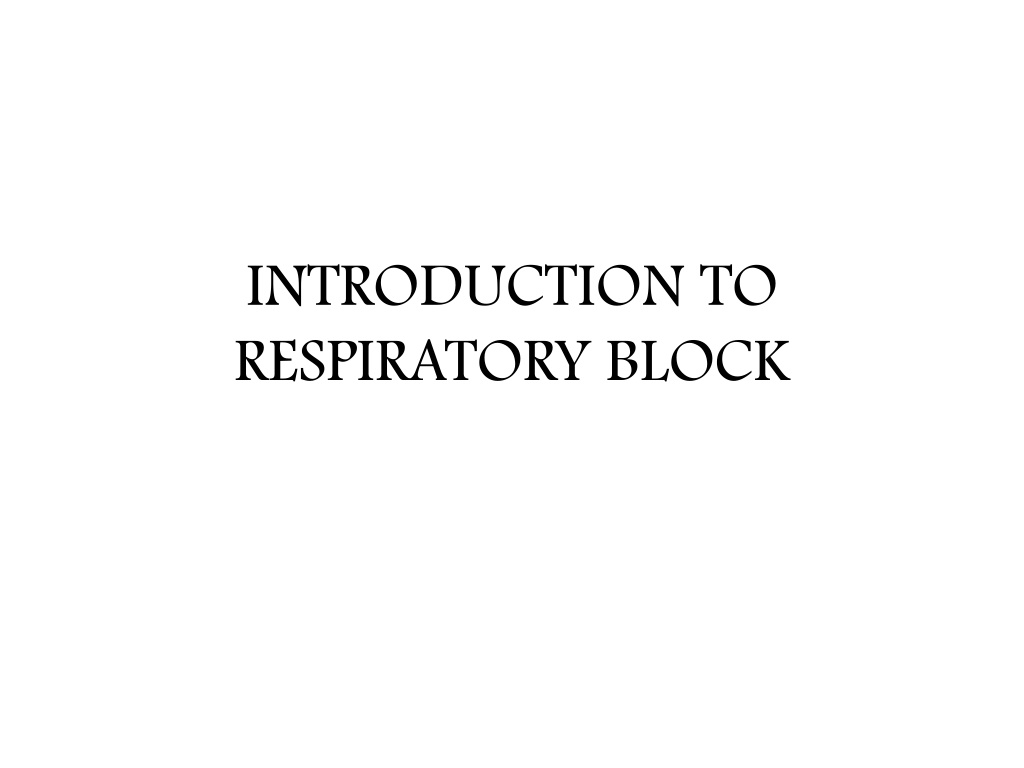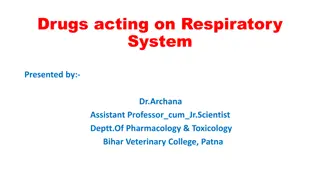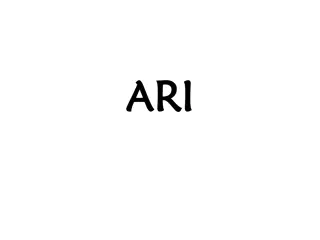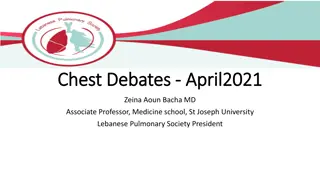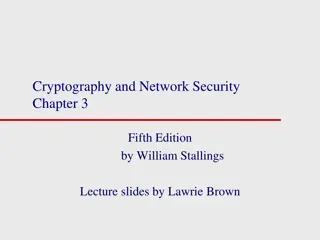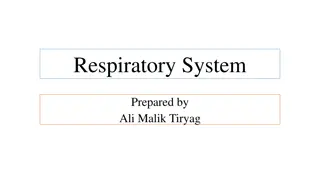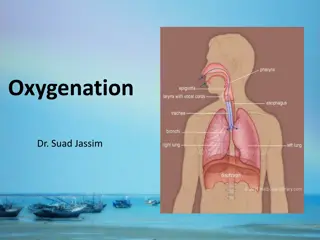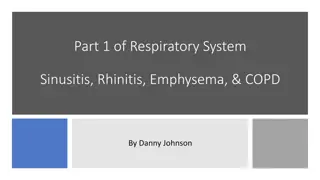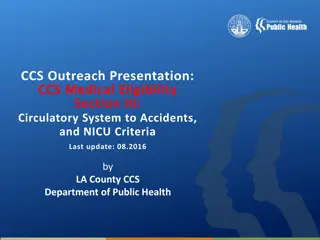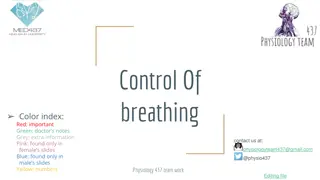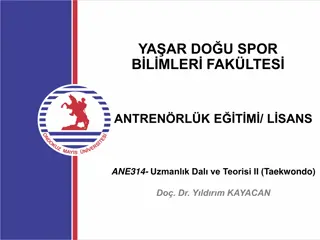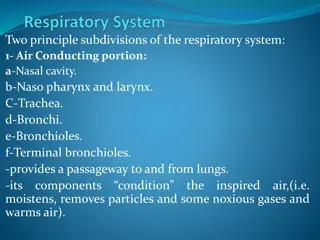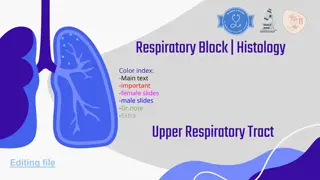Comprehensive Overview of Respiratory Block for Medical Students
This respiratory block introduces students to the anatomy, histology, muscles involved in respiration, embryology, radiological anatomy, and management of respiratory disorders. It covers topics like the nasal cavity, pharynx, larynx, trachea, bronchi, lungs, pleura, bronchial tree, and mediastinum. The module focuses on understanding normal respiratory system function, diagnosing respiratory disorders, and planning relevant investigations. Various teaching modes such as lectures, problem-based learning, and practicals are utilized to enhance learning.
Download Presentation

Please find below an Image/Link to download the presentation.
The content on the website is provided AS IS for your information and personal use only. It may not be sold, licensed, or shared on other websites without obtaining consent from the author. Download presentation by click this link. If you encounter any issues during the download, it is possible that the publisher has removed the file from their server.
E N D
Presentation Transcript
INTRODUCTION TO RESPIRATORY BLOCK
Modes of teaching Teaching of this block contents will be in the form of : Lectures problem based learning Practicals.
ANATOMY & HISTOLOGY OF NASAL CAVITY & PHARYNX ANATOMY & HISTOLOGY OF NASAL CAVITY & PHARYNX Nasal cavity: boundaries, lateral wall. Paranasal sinuses: names, functions, openings. Pharynx: parts. Microscopic structures of: vestibule of nose, respiratory & olfactory mucosa, nasal septum, mucosa of paranasal sinuses, larynx.. MUSCLES INVOLVED IN NORMAL RESPIRATION MUSCLES INVOLVED IN NORMAL RESPIRATION - Bones and joints of thoracic cage. - Respiratory movements - Inspiratory & expiratory muscles. ANATOMY OF LARYNX, TRACHEA & BRONCHI ANATOMY OF LARYNX, TRACHEA & BRONCHI - Larynx & trachea: extent, structure & functions. - Bronchial tree: structure, subdivisions & functions. EMBRYOLOGY OF RESPIRATORY SYSTEM EMBRYOLOGY OF RESPIRATORY SYSTEM - Important notes in development of larynx, trachea & lung. ANATOMY OF PLEURA & LUNG ANATOMY OF PLEURA & LUNG - Pleura: subdivisions, recesses, surface anatomy, supply. - Lungs: shape, relations, supply. - Difference between right & left lungs. HISTOLOGY OF LUNG & BRONCHIAL TREE HISTOLOGY OF LUNG & BRONCHIAL TREE - Microscopic structures of the wall of: trachea, bronchi, bronchioles, pleura. RADIOLOGICAL ANATOMY OF CHEST RADIOLOGICAL ANATOMY OF CHEST Postero-anterior radiograph of chest. Postero-anterior bronchogram . Lateral radiograph of chest, after barium swallow. Coronary angiogram. MEDIASTINUM MEDIASTINUM - Definition, subdivisions, boundaries & contents of each mediastinum.
Introduction Introduction Prof.Kambal Prof.Kambal , Dr. Reem Reem Sallam Ishfaq Ishfaq Bukhari Bukhari, Dr. members of the block committee members of the block committee Sallam and other and other
The Respiratory Module is a 4 week With the following major learning objectives. 1 1. . Understand Understand normal normal structure structure and and function function of of the the Respiratory Respiratory system system. . 2 2. . Describe Describe the asthma, asthma, Allergy, the etiology etiology and Allergy, COPD, COPD, respiratory and the respiratory tract the pathogenesis pathogenesis of of common tract infections common respiratory respiratory disorders infections and and pulmonary pulmonary tuberculosis) disorders ( (Broncila tuberculosis). . Broncila 3 3. . Correlate Correlate clinical clinical features features to to the the pathophysiology pathophysiology of of the the disease disease. . 4 4. . Take Take a a relevant tract tract disorders disorders. . 5 5. . Plan Plan out out investigations investigations to to diagnose relevant history history and and perform perform a a clinical clinical examination examination to to diagnose diagnose respiratory respiratory diagnose and and manage manage respiratory respiratory disorders disorders. . 6 6. . Describe Describe principles disorders disorders ( (Broncila tuberculosis) tuberculosis). . principles of of the Broncila asthma, the pharmacological pharmacological basis asthma, Allergy, Allergy, COPD, basis in in the respiratory tract the treatment treatment of of tract infections infections and respiratory respiratory and pulmonary pulmonary COPD, respiratory 8 8. . Describe Describe cigarette cigarette smoking smoking problems problems and and their their solution solution . . 9 9. . Describe Describe the the basic basic management management of of the the respiratory respiratory disorders disorders 10 10. . Be Be able able to to diagnose, diagnose, manage manage and and counsel counsel patients patients with with respiratory respiratory disorders disorders
Pharmacotherapeutic profile of anticholinergic and agrenergic drugs Pharmacology of various classes of drugs used in the management of Asthma and COIPD. Drugs used in the management of anaphylaxis, cough and rhinitis. General concept of antibiotics and rational of the use of antibiotics in respiratory tract infections. Pharmacotherapy of Tubercolosis , mechanism, selection and safety profile of Anti-TB drugs.
Lec Lec 1: Globular Proteins 1: Globular Proteins Upon completion of this lecture, students should be able to: Lec Lec 2: 2: Phospholipid Phospholipid (PL) Compounds Compounds (PL) Lec Lec 3 3: Respiratory : Respiratory Chain Chain Upon completion of this lecture, students should be able to: understand how Energy-rich molecules are metabolized by a series of oxidation reactions. be familiar with the process of electron transport chain and the relevant reactions taking place in mitochondria. of Physiological of Physiological Importance Importance understand what are globular proteins; their types & functions; with special emphasis on hemoglobin, myoglobin, & globulins In this lecture, students will be introduced to the following: Selected members of PLs Physiological importance of PLs Lung surfactant: structure, function, & clinical application. Types and functions of Plospholipases be familiar with Diseases associated with globular proteins
RESPIRATORY PHYSIOLOGY RESPIRATORY PHYSIOLOGY (BLOCK) (BLOCK) Functions and Organization of the Respiratory Functions and Organization of the Respiratory System System Mechanics of breathing Mechanics of breathing Respiratory ventilation Respiratory ventilation Lung Function in Health and disease Lung Function in Health and disease Gas Exchange and Gas Transfer Gas Exchange and Gas Transfer Oxygen and Carbon dioxide Transport Oxygen and Carbon dioxide Transport Hypoxia and cyanosis Hypoxia and cyanosis Control of breathing Control of breathing Effects of low and high gas pressure on the Effects of low and high gas pressure on the body body Effects of exercise on the respiratory Effects of exercise on the respiratory system system
RESPIRATORY BLOCK (OBJECTIVES AND PATHOLOGY LECTURES CONTENTS) RESPIRATORY BLOCK (OBJECTIVES AND PATHOLOGY LECTURES CONTENTS) Number of Lectures: 5 Number of Practicals: 2 Tutors: Dr. Ammar Al-Rikabi (male students) ammar_rikabi@hotmail.com Dr. Maha Arafah (female students ) - marafah@hotmail.com Dr. Marie (male practicals) Dr. Shaesta Zaidi (female practicals) snz24@yahoo.com
LECTURE ONE : Pathology and pathogenesis of bronchial asthma. LECTURE ONE : Pathology and pathogenesis of bronchial asthma. OBJECTIVES: OBJECTIVES: At the end of this lecture, the student should be capable of: A] bronchoconstriction caused by increased responsiveness of the tracheobronchial tree to various stimuli. Understanding asthma as an episodic, reversible B] atopic allergic and intrinsic asthma. Knowing that asthma is divided into two basic types: extrinsic or C] cases of severe asthma. Understanding the morphological changes seen in the lungs in
CONTENTS: CONTENTS: 1] diseases. Definitions of asthma as one of the chronic obstruction airway 2] extrinsic (non-immune) asthma. Types and pathogenesis of extrinsic (immune) asthma and 3] bronchial tree in cases of asthma. Clinical presentation and pathological changes seen in the 4] bronchitis and pulmonary emphysema. Complications of asthma: superimposed infection, chronic 5] Definition and manifestations of status asthmaticus.
LECTURE TWO: : Chronic obstructive airway diseases: chronic bronchitis, LECTURE TWO: : Chronic obstructive airway diseases: chronic bronchitis, emphysema and bronchiectasis. emphysema and bronchiectasis. OBJECTIVES: OBJECTIVES: At the end of this lecture, the students should be able to: A] resistance to airflow, owing to partial or complete obstruction at any level of the bronchial/bronchiolar. Understand that this group of disorders is characterized by an increase in B] asthma and bronchiectasis. Know that the major obstructive disorders are chronic bronchitis, emphysema, C] breathing) but each have their own clinical and anatomical characteristics. Is aware that the symptom common to all these disorders is "dyspnea" (difficulty in D] Chronic bronchitis and emphysema almost always coexists.
CONTENTS: CONTENTS: 1] smoking and air pollution, pathological changes and complications with special emphasis on cor pulmonale. Chronic bronchitis: definition, clinical presentation, role of cigarette 2] emphysema including centrilobular emphysema, panacinar emphysema (deficiency of alpha one antitrypsin), paraseptal and irregular emphysema. Emphysema: definition and clinical characteristics. Types of 3] emphysema and pneumothorax. Complications of emphysema with special emphasis on interstitial 4] (primary ciliary dyskinesia) and pathological features of bronchiectasis. Bronchiectasis: definition, predisposing factors, kartagener's syndrome
LECTURE THREE LECTURE THREE: Restrictive lung diseases. Restrictive lung diseases. OBJECTIVES: OBJECTIVES: At the end of this lecture, the student should be able to: A] well as the restrictive changes which occur in these diseases and lead to the development of symptoms of progressive breathlessness and cough in affected patients. Understand the structure and constituents of the lung interstitium as B] their type. This pathogenesis include the influx of inflammatory cells into the alveoli and alveolar walls, distortion of the normal structure of alveoli, release of chemical mediators and promotion of fibrosis (honey-comb lung). Appreciate the pathogenesis of interstitial lung diseases regardless of C] Become aware of the classification of interstitial lung diseases.
CONTENTS: CONTENTS: 1] Definition and causes of restrictive pulmonary diseases. 2] chest wall or neuromuscular diseases that restrict lung expansion or conditions leading to interstitial accumulations of cells or non-cellular substances. Pathogenesis of restrictive pulmonary diseases which include abnormalities in the 3] Brief Brief account on the clinicopathological features of: Adult and neonatal respiratory distress syndromes. Anthracosis and coal worker's pneumoconiosis. Silicosis and asbestosis. Hypersensitivity pneumonitis (extrinsic allergic alveolitis). Goodpasture syndrome. Eosinophilic granuloma. Idiopathic pulmonary fibrosis. Sarcoidosis.
LECTURE FOUR: TUBERCULOSIS LECTURE FOUR: TUBERCULOSIS OBJECTIVES OBJECTIVES At the end of this lecture, the student should be able to: A] Define tuberculosis. B] List organs that are commonly affected by tuberculosis. C] Epidemiology of Tuberculosis. D] Recognize the morphology of Mycobacteria. E] Recognize different phases of tuberculosis F] Know the basis and use of tuberculin skin (Mantoux) test. G] List the common clinical presentations, complications and prognosis of tuberculosis.
CONTENTS: CONTENTS: 1] Definition and causes of Tuberculosis including its epidemiology. 2] Pathogenesis of granuloma formation and its morphology. 3] In regard to Mycobacterial lung infection: Compare and contrast the following in relation to their gross and histologic lung pathology: primary tuberculosis (include a definition of the Ghon complex). secondary or reactivation tuberculosis. miliary tuberculosis. 4] Brief Brief account on the clinicopathological features of tuberculosis. 5] Diagnosis and the basis of tuberculin skin (Mantoux) test. 6] Brief Brief account on the complications and prognosis of tuberculosis.
LECTURE FIVE: Pathology of lobar pneumonia and bronchopneumonia. LECTURE FIVE: Pathology of lobar pneumonia and bronchopneumonia. OBJECTIVES: OBJECTIVES: At the end of this lecture, the student should be able to: A] characterized by consolidation (solidification) of the pulmonary tissue. B] Is aware of the pathogenesis of pneumonia and its classification which principally include bronchopneumoniae, lobar pneumonia and atypical pneumonia. Understand that pneumonia is an inflammatory condition of the lung C] Is able to appreciate the aetiology and pathogenesis of lung abscess.
CONTENTS: CONTENTS: 1] General considerations and clinical characteristics of pneumonia. 2] bronchopneumonia and interstitial pneumonia (atypical pneumonia) with special emphasis on mycoplasma pneumonia, viral pneumonia and ornithosis (Chlamydia induced). Morphologic types of pneumonias including lobar pneumonia, 3] infection in patients with AIDS. Pneumocystis carinii pneumonia as the most common opportunistic 4] Hospital acquired gram negative pneumonias. 5] Lung abscess: causes and manifestations.
LECTURE SIX: TUMOURS OF THE LUNG LECTURE SIX: TUMOURS OF THE LUNG OBJECTIVES: OBJECTIVES: At the end of this lecture, the student should be able to: A] factors of bronchogenic carcinoma. Understand the incidence, age group of affected patients and predisposing B] squamous carcinoma, adenocarcinoma, small cell and large cell (anaplastic) carcinomas. Is aware of the classification of bronchogenic carcinoma which include: C] carcinoma. Understands the clinical features and gross pathology of bronchogenic D] emphasis on small cell carcinoma and bronchial carcinoid. Have a basic knowledge about neuroendocrine tumours with special E] Is aware that the lung is a frequent site for metastatic neoplasms.
CONTENTS: CONTENTS: 1] including superior Vena Cava syndrome, pancoast tumour, hoarseness, pleural effusion and paraneoplastic endocrine syndromes. Bronchogenic carcinoma: aetiology, epidemiology, clinical features 2] carcinoma, adenocarcinoma, bronchioloalveolar carcinoma, small cell carcinoma, large cell carcinoma, carcinoid tumour and metastatic carcinoma to the lung. Types, location and clinicopathological characteristics of squamous cell 3] Primary and secondary tumours of the pleura.
Immunology Unit Immunology Unit (Two Lectures) Lecturers: Immunology of bronchial asthma Immunology of bronchial asthma Allergens in induction of allergic inflammation Cytokines in pathogenesis of asthma Airway remodeling in asthma Dr. Adel Almogren Prof. Zahid Shakoor Immunology of tuberculosis Immunology of tuberculosis Immune handling of M. tuberculosis Cytokines and TB Tuberculin test Prof. Zahid Shakoor Immunology Unit
Microbiology (Prof. Microbiology (Prof. Kambal Tuberculosis Causative agents mycobacterium tuberculosis complex (MTBC) Non tuberculosis mycobacterium (NTM) Difference between MTBC & NTM Morphology differences Culture methods Susceptibility Testing Importance of tuberculosis as a mainly respiratory diseases Kambal) ) Cause of Upper Respiratory Tract Infection Importance of sore throat by group A and and its complications. Viral causes of Respiratory Tract Infection - Influenza, Rhinoviruses etc. Fungal causes of Respiratory Infection. Commonly acquired pneumonia (bacterial cause). Hospital acquired pneumonia caused by multidrug resistant bacteria.
